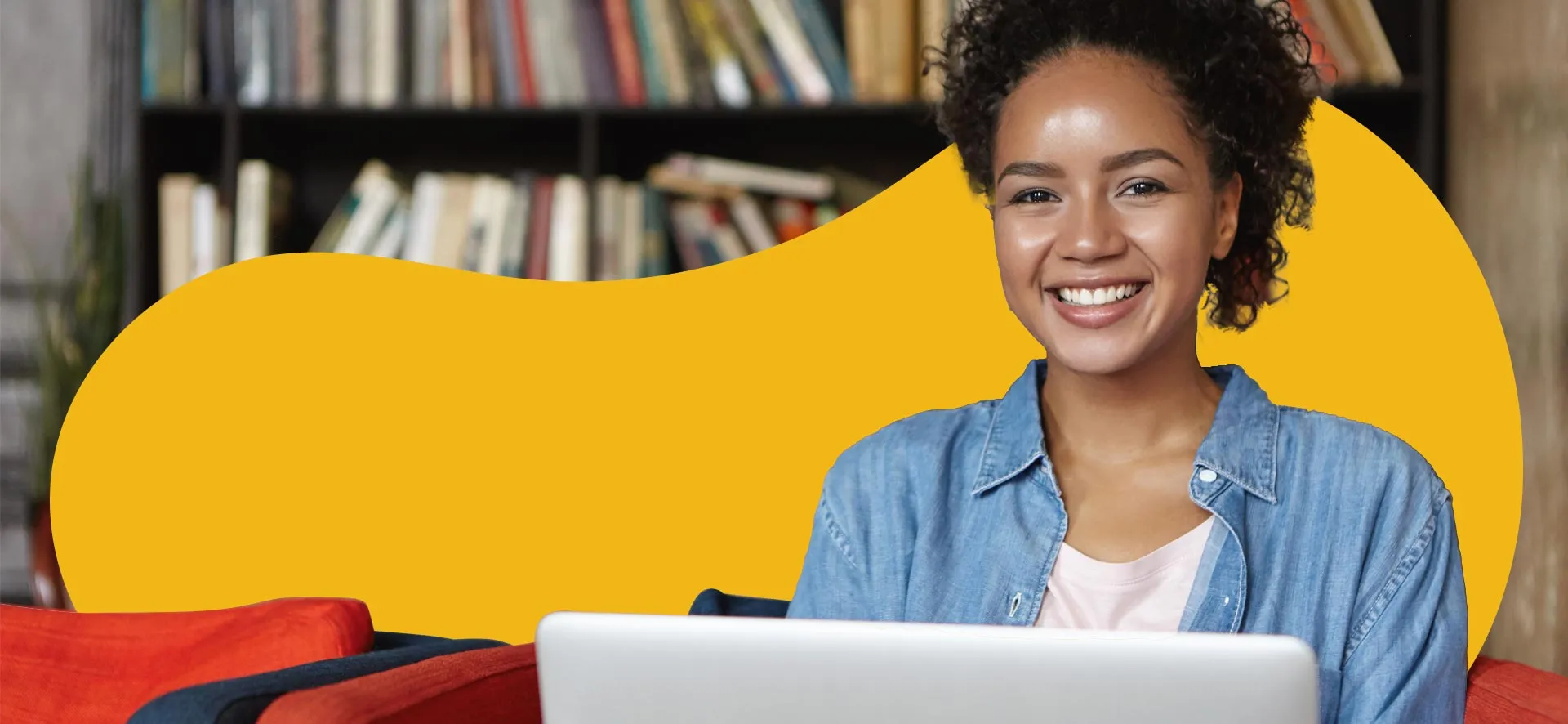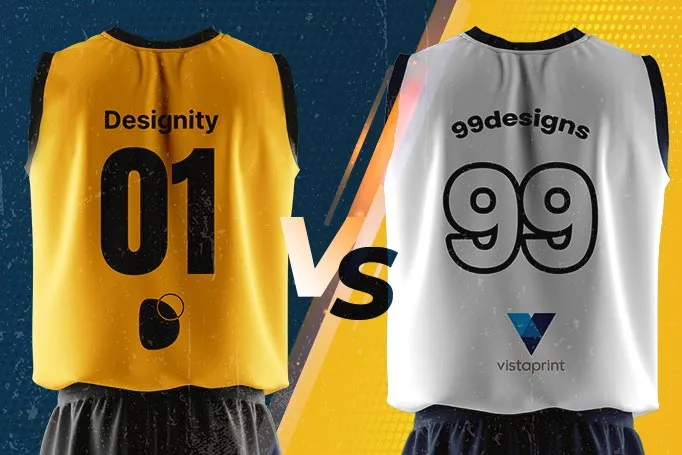There is no shortage of design companies and creative agencies to take on your most pressing projects. If you printed your Google search query all on one long page, we’re sure it would be the length of a whole New York City block (or a CVS receipt).
Choosing one may be just as hard as picking only one streaming service forever, or just one kind of candy. With so many design businesses to choose from, how does a brand go about making the final choice? Especially when that final choice is between two great companies.
We’re going to take some of that weight off your shoulders and narrow it down to two: here is our comparison of 99designs vs. Designity.
Who is 99designs?
99designs is a crowdsourcing marketplace that’s based in Melbourne, Australia. What initially started as a small spin-off to the web developer forum, Sitepoint, eventually became the freelance marketplace that it is today.
They were acquired by Cimpress, the parent company of Vistaprint, in October of 2020.
Who is Designity?
Designity is a collaborative US-based platform for creatives of all backgrounds, experience levels, and specialties. This allows them to form virtual teams to support companies with a wide variety of design and marketing projects.
All of the creative teams are supervised by a designated creative director as the main point of contact to create consistency and a hassle-free experience for clients.
A comparison at first glance.
You may be thinking “these two companies sound exactly the same…how are they different?” Sure, they’re both internet/online design marketplaces with tons of creatives, but that’s the only similarity that these two platforms share. Here is the high-level comparison:
Let’s take a closer look at how these companies work and what makes them so different.
Client onboarding.
99designs
99design’s onboarding process is fairly straightforward. Potential customers sign up for an account online. There is no real onboarding process, introduction into how the platform works, or any guidance on navigating their site.
You do have the option to call their customer support number and they also have a ‘submit a request’ option that connects you with an agent via email. Other than that, you navigate your own onboarding process from start to finish.
This is certainly a plus for people who know exactly what they’re looking for and just want to get right to business. If you are someone who likes a little bit more guidance, this might be a thorn in your shoe.
Designity
Designity’s onboarding process is, for lack of a better word, detailed. You request a consultation call with one of their agents and are walked through the platform and process from inception to deliverable.
You are assigned a creative director after the initial onboarding discovery. The creative director is matched with you based on personality, industry expertise, and project-specific requirements. Their job is to navigate the creative process with you from start to finish.
<div class="c-blog_comp-cta cc-component-1"><div class="c-blog_comp-cta-left"><div class="c-blog_comp-cta-left-wrap"><img src="https://global-uploads.webflow.com/61cdf3c5e0b8155f19e0105b/6334d81a29c751ccd8c26638_brain-orchestra.png" loading="lazy" alt="" sizes="(max-width: 479px) 93vw, (max-width: 767px) 96vw, 363px" srcset="https://global-uploads.webflow.com/61cdf3c5e0b8155f19e0105b/6334d81a29c751ccd8c26638_brain-orchestra-p-500.png 500w, https://global-uploads.webflow.com/61cdf3c5e0b8155f19e0105b/6334d81a29c751ccd8c26638_brain-orchestra.png 500w" class="c-blog_comp-cta-left-img"></div></div><div class="c-blog_comp-cta-right"><div class="c-blog_comp-content"><div class="c-text-wrapper cc-mb-32"><div class="c-title-4 cc-bold"><strong>Want to save money without sacrificing the quality?</strong></div></div><div class="c-text-wrapper"><div class="c-text-2">Say goodbye to traditional, expensive agencies and unreliable marketplaces. Say hello to Designity.</div></div></div><div class="c-blog_comp-wrapper"><a href="/pricing" target="_blank" class="c-button cc-primary cc-inverted w-button"><strong>Get Your 2-Week Trial</strong></a></div></div></div>
The creative vetting process.
99designs
The 99designs platform is a freelance marketplace. This means that they are not responsible for vetting, sourcing, or reviewing the creatives on their platform; the end-user is responsible for this part of the process.
The designers that you find on 99designs could also be located anywhere in the world. While this is a negative for some, it doesn’t have to be. For example, it could be beneficial to a company looking to break into an international market.
If an American company is opening a branch in Spain, having a designer who is Spanish and understands the market would be more effective than a US-based designer without any experience in the Spanish market.
Designity
Designity’s vetting process for creatives is more intensive and exclusive than 99designs. Designity only works with US-based creatives who have to pass an in-depth vetting process.
This includes a challenge that they are required to complete within a specific amount of time, ensuring that their talents are fresh, real, and reliable. To put this into perspective, Designity only accepts 5% of applicants.
Designity foregoes the fancy alma maters in favor of real, raw talent. Sometimes, that freshness can be found in emerging designers who are typically overlooked because they don’t have years' worth of experience.
Your creative team is assembled based on your project needs and is also interchangeable as needed.
Sourcing and supervising.
99designs
The process of finding a designer with 99designs is quite different than using a branding and design agency. Let’s say that you are a marketing manager with a custom graphic design project.
You would have to enter their marketplace and search for graphic designers yourself. As in, filter, sort, and sift, through their freelance marketplace until you narrow it down to your chosen one. Another option is to start a ‘Contest’.
Their contests typically span a total of seven to eight days. Four of those days are focused on getting the designers and you have another three to four days to narrow down and refine your selection to one.
The same process applies if you decide to switch creatives.
With 99designs, your creative team is not interchangeable; you have to repeat this process if you want to add/switch creatives.

Designity
We touched on creative directors earlier but in order to understand the sourcing and supervising process with Designity, you have to understand the purpose of their creative directors.
Designity acts as an extension of your internal team by making sure that you never have to supervise, manage, or source your own creatives. The creative director’s job is to tap into Designity’s pool of vetted creatives and plug them into your projects as needed.
It’s also their job to supervise those creatives throughout your project journey so that you don’t have to. This is very beneficial for marketers who don’t have the bandwidth to source and supervise their own creative team and only want one point of contact throughout the project.
For people who would rather take a more hands-on approach, this may not be their favorite feature. Creative directors are an integral part of working with Designity and can’t be eliminated from the process; in order to access their creatives, you have to work with their CDs.
Timelines, requests, and revisions.
99designs
The nature of working with a freelance marketplace like 99ddesigns is that your project timelines and the number of requests and revisions that you get depend entirely on the freelancer that you hire.
Keep in mind that you may be charged for every revision. While hiring creatives through 99designs may be cheaper than working with Designity (because many of them are international), the cost ends up leveling out if your creative charges per revision.
Like requests and revisions, your timeline for a given project may vary, especially if you are working with someone outside of your time zone. There is no guarantee that your project will be completed on time or how much it will cost in the end.
If your timelines are flexible, then this isn’t that big of a deal. If you are under strict deadlines, then this could be a con. It’s important to note that most freelancers are on top of their deadlines, so the likelihood of them dropping the ball is slim.
Designity
Part of Designity’s model is that your creative director is in charge of creating guaranteed timelines for your projects. They give you access to a dashboard where you can see every project stage, how long each one will take, and when you can expect deliverables.
This dashboard is regularly updated, so you’re never left wondering “What is going on with my project? What are the timelines? When am I going to get my deliverables?”
Another huge perk is the number of project requests and revisions that clients get. There isn’t a specific number because these are unlimited—literally.
How much do they cost?
99designs: How it works
99designs’ cost depends entirely on your project. You would have to sign up for their service (at no cost) and find/hire your chosen creative.
At that point, you would submit a payment for the project and 99designs holds that payment until the project is completed. The funds are then released to the designer.
For the contest, however, you are required to pay an upfront contest fee in full. If you do not like any of the entries or decide to go a different route, you have to contact them directly to get a refund.
Designity: How it works
Designity functions as a monthly plan. There are package options available that depend on the number of creatives on your project, and the minimum monthly payment is $3000.
The higher the plan, the bigger the team, the more experienced the creatives are, the faster turnaround times will be, and the more categories you have to choose from.
Renewals can be monthly, quarterly, or annually, whatever works best for you.
Their 2-week trial period allows you to take your creative team for a test drive before you sign up for one of the packages.
In a nutshell, Designity’s payment model gives clients unlimited design requests, revisions, and a team of creatives who are supervised by a creative director for one monthly fee.
Customer Success
99designs
While there are many perks to working with a company like 99designs, one drawback for potential clients is their hands-off approach to customer success.
Unless you contact them directly, you don’t get regular check-ins. Like everything else in their process, it’s up to you to navigate your expectations. This doesn’t have to be a drawback, however. Preferences are different, and some prefer a more independent approach.
Designity
From onboarding to completion of a project, Designity functions as an extended arm of your own team. You only have one point of contact which means that you aren’t overwhelmed by calls and emails.
You get a weekly video call with your creative director, giving you the time you need to review timelines and get a handle on where the creative team is on your project. The same thing goes for customer success and satisfaction.
With Designity, you get ‘temperature checks’ from their customer success team. They check in with you on a monthly basis to gauge how your experience is going and to tweak things as needed.
Designity or 99designs? The verdict.
In the end, choosing the better buy is wholly dependent on your own specific needs. Before you make your final decision, ask yourself:
Every design company and creative agency has its strengths and weaknesses, it just all depends on your own unique needs.
We hope this helped narrow down your search. Stay tuned for more comparisons!
{{cta}}



